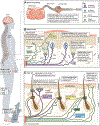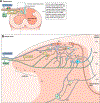Uncovering the Cells and Circuits of Touch in Normal and Pathological Settings - PubMed (original) (raw)
Review
Uncovering the Cells and Circuits of Touch in Normal and Pathological Settings
Francie Moehring et al. Neuron. 2018.
Abstract
The sense of touch is fundamental as it provides vital, moment-to-moment information about the nature of our physical environment. Primary sensory neurons provide the basis for this sensation in the periphery; however, recent work demonstrates that touch transduction mechanisms also occur upstream of the sensory neurons via non-neuronal cells such as Merkel cells and keratinocytes. Within the spinal cord, deep dorsal horn circuits transmit innocuous touch centrally and also transform touch into pain in the setting of injury. Here non-neuronal cells play a key role in the induction and maintenance of persistent mechanical pain. This review highlights recent advances in our understanding of mechanosensation, including a growing appreciation for the role of non-neuronal cells in both touch and pain.
Keywords: Piezo2; dorsal horn; ion channels; keratinocytes; mechanical allodynia; mechanotransduction; microglia; non-neuronal cells; skin; spinal touch circuit.
Copyright © 2018. Published by Elsevier Inc.
Figures
Figure 1.. Sensory Neurons and Non-neuronal Cells Important for Touch Transduction in Hairy and Glabrous Skin
(A) Cell bodies of the dorsal root ganglia (DRG) neurons are found near the spinal cord, where they extend a centrally projecting axon to the dorsal horn and a distal projecting, longer axon to the hairy and glabrous skin (or deeper muscle, bone, or tendon tissue; not shown). Aβ-fibers are thickly myelinated, fast conducting, and generally have large-diameter cell bodies; Aδ-fibers are thinly myelinated, conduct at medium speed, and generally have medium-diameter cell bodies, Non-myelinated C-fibers conduct much more slowly and generally have smaller cell bodies. (B) Glabrous skin innervation shows the diversity of somatosensory neurons that terminate within the thick layer of the epidermis (between keratinocytes) and the underlying dermis. Keratinocytes can communicate with the distal terminals of noxious-detecting peptidergic (deeper) and non-peptidergic C-fibers (more superficial), as well as with the terminals of Aδ-fibers and Aβ-fibers. Aβ-fiber endings innervate Merkel cell complexes and aid in touch sensation by helping shape our detection of two-point discrimination. (C) The mammalian hairy skin is comprised of a thinner layer of the epidermis and contains three different type of hairs, where each afferent type can be identified by its innervation pattern of the hair follicle as well as its morphology. For example, Guard hairs are the least abundant and longest hair and are innervated by Aβ-fibers, which have circumferential endings. Zigzag hairs, on the other hand, are the most abundant, have a distinct zigzag shape, and are innervated by C-fibers or Aδ-fibers that have circumferential endings. All mammals except humans are equipped with these highly differentiated touch organs.
Figure 2.. Spinal Cord Circuits Important for Touch and Pain Processing
(A) High-threshold (HT) C- and Aδ-fibers that transmit pain, itch, and temperature project to the dorsal laminae I and II. Low-threshold (LT) C- and A5-fibers that transmit aspects of touch project to lamina II inner and III. Aδ-fibers that transmit touch information project directly through the dorsal columns to the brainstem as well as send collaterals into the deeper dorsal horn laminae Iii-IV. This region is known as the low-threshold mechanosensor-recipient zone (LTMR-RZ). Descending cortical projections modulate touch and innervate specifically the LTMR-RZ. (B) LTMRs innervate neurons in the LTMR-RZ, including excitatory vertical cells (Ver), VGLUT3 interneurons, RORa interneurons, and post-synaptic dorsal column (PSDC) neurons as well as inhibitory dynorphin (Dyn), parvalbumin (PV), and islet cells. Vertical cells receive inputs from all types of afferents as well as a large number of intrinsic neuronal populations. VGLUT3 neurons directly or indirectly innervate the Cr and PKCγ populations; however, a cell population in this pathway remains uncharacterized. PSDC neurons ascend through the postsynaptic dorsal column tract of the dorsal horn. RORα neurons receive inputs from descending corticospinal tract, and connect to premotor (PMN) and motor neurons (MN) in the ventral horn. These dorsal horn neurons modulate motor function in concert with somatosensory inputs.
Similar articles
- Piezo2 is the major transducer of mechanical forces for touch sensation in mice.
Ranade SS, Woo SH, Dubin AE, Moshourab RA, Wetzel C, Petrus M, Mathur J, Bégay V, Coste B, Mainquist J, Wilson AJ, Francisco AG, Reddy K, Qiu Z, Wood JN, Lewin GR, Patapoutian A. Ranade SS, et al. Nature. 2014 Dec 4;516(7529):121-5. doi: 10.1038/nature13980. Nature. 2014. PMID: 25471886 Free PMC article. - Mammalian touch catches up.
Walsh CM, Bautista DM, Lumpkin EA. Walsh CM, et al. Curr Opin Neurobiol. 2015 Oct;34:133-9. doi: 10.1016/j.conb.2015.05.003. Epub 2015 Jun 19. Curr Opin Neurobiol. 2015. PMID: 26100741 Free PMC article. Review. - Transduction and encoding sensory information by skin mechanoreceptors.
Hao J, Bonnet C, Amsalem M, Ruel J, Delmas P. Hao J, et al. Pflugers Arch. 2015 Jan;467(1):109-19. doi: 10.1007/s00424-014-1651-7. Epub 2014 Nov 23. Pflugers Arch. 2015. PMID: 25416542 Review. - Role of microtubules in Piezo2 mechanotransduction of mouse Merkel cells.
Chang W, Gu JG. Chang W, et al. J Neurophysiol. 2020 Dec 1;124(6):1824-1831. doi: 10.1152/jn.00502.2020. Epub 2020 Oct 21. J Neurophysiol. 2020. PMID: 33085566 Free PMC article. - Merkel cells and neurons keep in touch.
Woo SH, Lumpkin EA, Patapoutian A. Woo SH, et al. Trends Cell Biol. 2015 Feb;25(2):74-81. doi: 10.1016/j.tcb.2014.10.003. Epub 2014 Dec 2. Trends Cell Biol. 2015. PMID: 25480024 Free PMC article. Review.
Cited by
- A spinal neural circuitry for converting touch to itch sensation.
Chen S, Gao XF, Zhou Y, Liu BL, Liu XY, Zhang Y, Barry DM, Liu K, Jiao Y, Bardoni R, Yu W, Chen ZF. Chen S, et al. Nat Commun. 2020 Oct 8;11(1):5074. doi: 10.1038/s41467-020-18895-7. Nat Commun. 2020. PMID: 33033265 Free PMC article. - Potential therapeutic targets for the treatment of opioid abuse and pain.
Kiguchi N, Ko MC. Kiguchi N, et al. Adv Pharmacol. 2022;93:335-371. doi: 10.1016/bs.apha.2021.09.002. Epub 2021 Nov 9. Adv Pharmacol. 2022. PMID: 35341570 Free PMC article. Review. - Crosstalk of Mast Cells and Natural Killer Cells with Neurons in Chemotherapy-Induced Peripheral Neuropathy.
Yun HD, Goel Y, Gupta K. Yun HD, et al. Int J Mol Sci. 2023 Aug 8;24(16):12543. doi: 10.3390/ijms241612543. Int J Mol Sci. 2023. PMID: 37628724 Free PMC article. Review. - Neuropathic pain caused by miswiring and abnormal end organ targeting.
Gangadharan V, Zheng H, Taberner FJ, Landry J, Nees TA, Pistolic J, Agarwal N, Männich D, Benes V, Helmstaedter M, Ommer B, Lechner SG, Kuner T, Kuner R. Gangadharan V, et al. Nature. 2022 Jun;606(7912):137-145. doi: 10.1038/s41586-022-04777-z. Epub 2022 May 25. Nature. 2022. PMID: 35614217 Free PMC article. - The Role of ATP Receptors in Pain Signaling.
Inoue K. Inoue K. Neurochem Res. 2022 Sep;47(9):2454-2468. doi: 10.1007/s11064-021-03516-6. Epub 2022 Jan 30. Neurochem Res. 2022. PMID: 35094248 Review.
References
- Adriaensen H, Gybels J, Handwerker HO, and Van Hees J (1983). Response properties of thin myelinated (A-delta) fibers in human skin nerves. J. Neurophysiol. 49, 111–122. - PubMed
- Aktar T, Chen J, Ettelaie R, and Holmes M (2015). Tactile sensitivity and capability of soft-solid texture discrimination. J. Texture Stud. 46, 429–439.
- Al-Chaer ED, Lawand NB, Westlund KN, and Willis WD (1996). Visceral nociceptive input into the ventral posterolateral nucleus of the thalamus: a new function for the dorsal column pathway. J. Neurophysiol. 76, 2661–2674. - PubMed
Publication types
MeSH terms
Grants and funding
- R37 NS108278/NS/NINDS NIH HHS/United States
- R01 NS107364/NS/NINDS NIH HHS/United States
- R56 NS104964/NS/NINDS NIH HHS/United States
- R01 NS040538/NS/NINDS NIH HHS/United States
- R01 NS070711/NS/NINDS NIH HHS/United States
LinkOut - more resources
Full Text Sources
Other Literature Sources

